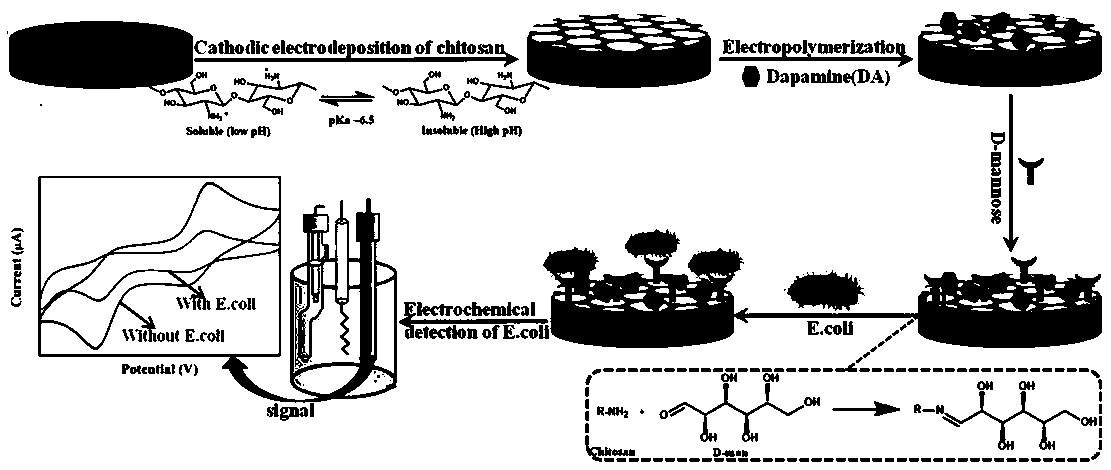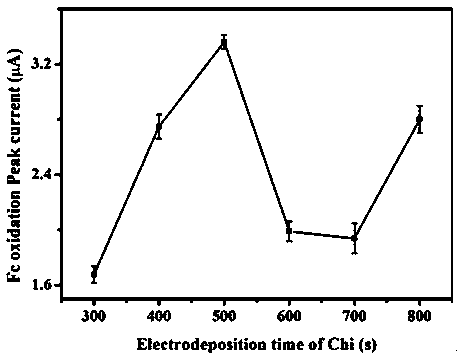Preparation and detection method of escherichia coli electrochemical biosensor
A technology of biosensor and Escherichia coli, which is applied in the field of biomedicine, can solve the problems of poor electrode stability, weak selectivity, and poor stability of electrochemical sensors, and achieve the effects of good stability, simple preparation, and strong selectivity
- Summary
- Abstract
- Description
- Claims
- Application Information
AI Technical Summary
Problems solved by technology
Method used
Image
Examples
Embodiment 1
[0053]Embodiment 1: step 1, the glassy carbon electrode, that is, the GCE electrode is placed in the chitosan solution, that is, the Chi solution, and the pH value of the Chi solution is adjusted to 6 with NaOH solution, and Chi is deposited on the GCE electrode by cyclic voltammetry; Washing and drying to obtain Chi-GCE electrodes;
[0054] Step 2, soak the Chi-GCE electrode in the dopamine solution, that is, the DA solution, and use a three-electrode system and cyclic voltammetry to electropolymerize DA to prepare a dopamine-chitosan-GCE modified electrode, that is, DA-Chi- GCE modified electrode, cleaned and dried;
[0055] Step 3, soak the DA-Chi-GCE modified electrode in D-mannose solution, that is, D-man solution, and use PBS solution concentration of 0.1 M / L to prepare D-mannose-dopamine-chitosan -GCE modified electrode, that is, D-man-DA-Chi-GCE modified electrode, forming a D-man-DA-Chi sensor;
[0056] Step 4, the D-man-DA-Chi-GCE modified electrode is placed in th...
Embodiment 2
[0081] Embodiment 2: step 1, place the glassy carbon electrode, i.e. the GCE electrode in the chitosan solution, i.e. the Chi solution, adjust the pH value of the Chi solution to 6 with NaOH solution, and deposit Chi to the GCE electrode by cyclic voltammetry; Washing and drying to obtain Chi-GCE electrodes;
[0082] Step 2, soak the Chi-GCE electrode in the dopamine solution, that is, the DA solution, and use a three-electrode system and cyclic voltammetry to electropolymerize DA to prepare a dopamine-chitosan-GCE modified electrode, that is, DA-Chi- GCE modified electrode, cleaned and dried;
[0083] Step 3, soak the DA-Chi-GCE modified electrode in D-mannose solution, that is, D-man solution, and use PBS solution concentration of 0.08 M / L to prepare D-mannose-dopamine-chitosan -GCE modified electrode, that is, D-man-DA-Chi-GCE modified electrode, forming a D-man-DA-Chi sensor;
[0084]Step 4, the D-man-DA-Chi-GCE modified electrode is placed in the double electron mediato...
Embodiment 3
[0085] Embodiment 3: Step 2 and Step 3 are interchanged to form Step N2 and Step N3:
[0086] Step 1, the glassy carbon electrode, that is, the GCE electrode is placed in the chitosan solution, that is, the Chi solution, the pH of the Chi solution is adjusted to 5 with NaOH solution, and Chi is deposited on the GCE electrode by cyclic voltammetry; cleaning and drying are obtained Chi-GCE electrodes;
[0087] Step N2, immerse the Chi-GCE electrode in D-mannose solution, that is, D-man solution, and use a PBS solution concentration of 0.15 M / L to prepare a D-man-Chi-GCE modified electrode, and wash ,dry;
[0088] Step N3, soaking the D-man-Chi-GCE modified electrode in a dopamine solution, that is, a DA solution, using a three-electrode system and cyclic voltammetry to electropolymerize DA to prepare dopamine-D-mannose-chitosan -GCE modified electrode, that is, DA-D-man-Chi-GCE modified electrode to form a DA-D-man-Chi sensor;
[0089] Step 4, the D-man-DA-Chi-GCE modified el...
PUM
 Login to View More
Login to View More Abstract
Description
Claims
Application Information
 Login to View More
Login to View More - R&D
- Intellectual Property
- Life Sciences
- Materials
- Tech Scout
- Unparalleled Data Quality
- Higher Quality Content
- 60% Fewer Hallucinations
Browse by: Latest US Patents, China's latest patents, Technical Efficacy Thesaurus, Application Domain, Technology Topic, Popular Technical Reports.
© 2025 PatSnap. All rights reserved.Legal|Privacy policy|Modern Slavery Act Transparency Statement|Sitemap|About US| Contact US: help@patsnap.com



